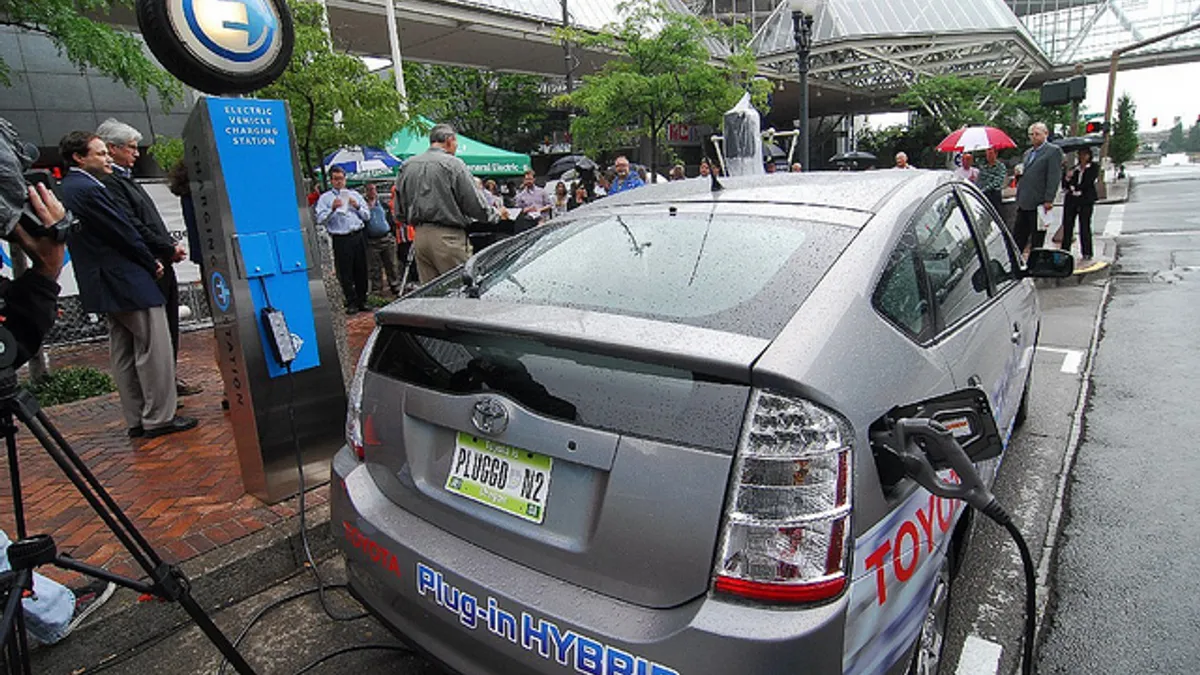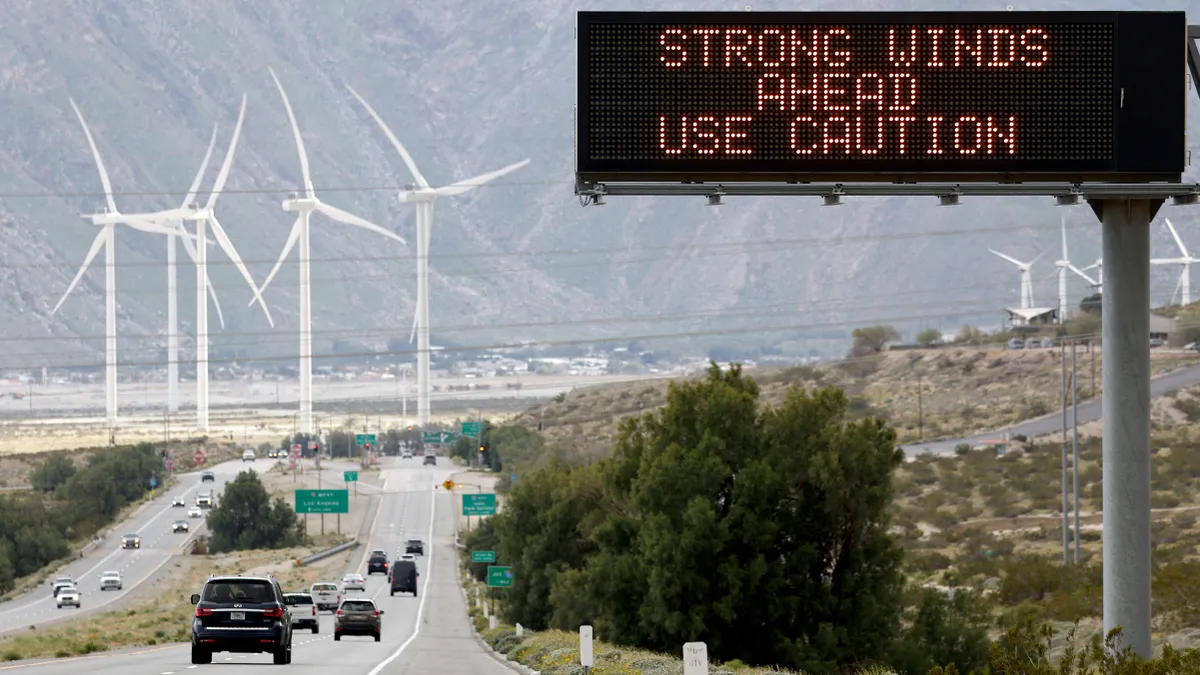As the transportation sector races towards inexorable change, there is a growing focus on state regulations and how they will enable significant growth of electric vehicles (EVs).
While there are a few clear leaders in electric vehicle adoption, and states like California and Hawaii are taking proactive approaches to charging infrastructure, the utility sector is by and large flying blind when it comes to developing policies simply because all of this is new.
Enter the National Association of State Energy Officials (NASEO), which has developed, along with Cadmus, a tool for states and localities to assess their policies and develop regulations that will encourage smart growth of charging infrastructure and vehicle adoption.
"This is designed to help governments take an overall look" at the set of policies in place, NASEO Senior Program Director Cassie Powers told Utility Dive.
The shift towards electrified transportation may have taken longer than many experts once imagined, but it now appears imminent. EVs could reach 2% of new car sales by the end of the year, car manufacturers are planning to roll out dozens of new models and utilities see opportunity for increased sales and revenues.
“EVs are rapidly growing but policies still play a really important role in sending signals to the private sector that a state or city is excited to support EVs and will help the private sector,"

Cassie Powers
Senior Program Director, National Association of State Energy Officials
The chicken-egg conundrum which experts have mulled for years — which comes first, chargers or vehicles? — is still open, but it has also become a near-term debate.
“EVs are rapidly growing but policies still play a really important role in sending signals to the private sector that a state or city is excited to support EVs and will help the private sector," Powers said. "It also shows cities or states have their own goals."
No surprise: Purchase incentives are most important
NASEO's rubric categorizes all plug-in electric vehicle policies into 6 categories and 14 subcategories, which are then assigned weights based on their strength in spurring adoption relative to other policies. Combined, they allow a slate of policies to be rated on a scale of 1 to 100.
“It was designed in the hope that states and localities will be able to use this to do research when evaluating their own policy environment," Powers said. Ideally, policymakers will review the rubric versus their current regulations "to learn what policies and programs work, and how they may want to tweak them," she said.
By far, the rubric assigns the highest weight to vehicle purchase incentives, which could include grants, rebates or tax credits, along with exemptions from sales tax, registration and licensing fees. NASEO set the weighting for purchase incentive policies at 30, and EV deployment targets at 20, making up half of a perfect score between the two.
The evidence "clearly indicates the importance of vehicle purchase incentives in encouraging customer adoption," the rubric explains, adding that the weighting is higher than for the deployment targets category "because the academic evidence is clearer and because of the historical examples of the boom-and-bust of plug-in electric vehicle (PEV) sales associated with these incentives."
The weightings were based on "an exhaustive literature review," that included reports and research from government sources, non-profits and others. The NASEO-Cadmus team "took an initial crack at the weightings," said Powers, and then showed the first draft to a technical advisory committee comprised of state energy officials and representatives from government, academia and non-profits.
Powers said the group “provided a gut check" that wound up leading to some changes in the policy weightings.
NASEO's literature review also produced a ranking of the most-to-least preferable incentives. Incentives at the time of purchase, such as dealer discounts and tax waivers, were most preferable, followed by rebates available immediately after purchase and then tax credits which could take weeks or months.
Surprise: Talking works, showing doesn't
It seems obvious that purchase incentives would be the most impactful EV policy these days. But the picture gets less clear from there, and Powers said there were some surprises — particularly when they took their draft weightings to their advisory committee.
Take policies that incentivize the electrification of fleets of vehicles — city buses, for example, or utility service vehicles. They are a popular policy that typically aims to "lead by example," as Edison Electric Institute President Tom Kuhn put it a few years ago. And there is strong evidence that high visibility of a technology, like rooftop solar panels, can spur neighbors to make the same decision.
EEI in 2014 released a white paper titled “Transportation Electrification: Utility Fleets Leading the Charge," which focused on the utility sector's efforts to speed the adoption of EVs in commercial and retail markets, beginning with electric utility fleets.
"The utility fleet is the point of the spear: it is a critical step toward mainstream electrification," the paper concluded.
But NASEO's rubric weights fleet policies at just 1 — a single point..
"While there is a proven relationship between increased visibility of a technology and reduced uncertainty about the costs of that technology, no evidence specifically demonstrates this relationship for fleet vehicles," the rubric explains. The findings go on to say that state and local government fleets are "typically so small as to
be relatively unnoticeable by the public."
Powers said fleet policies do not show sufficient results to merit their popularity, but she also cautioned that there is not a large body of research on their impacts yet.
"It was our initial impression there would be a higher degree of weighting for fleet policies," she said, but the working group found there is “not too much evidence that policies supporting fleet adoption have a high degree of influence."
According to EEI, over the last three years, utilities have invested approximately $300 million in plug-in vehicles and technologies, which are receiving more than 10% of their fleet budgets.
Another surprise came from an examination of marketing and communications policies, which aim to increase the level of public awareness of EVs. The rubric weights it at 9 points, because of "strong evidence from the literature showing that consumers are ill-informed about the technical and economic aspects of PEVs."
Powers said the technical advisory committee had actually recommended the policies be weighted even higher, but the group balked because the evidence linking marketing programs to EV adoption was not strong enough.
“One of the challenges, within the context of this analysis focused on what policies support adoption of electric vehicles, is that there are lots of marketing efforts that aren't based in policy," Powers said.
Charging infrastructure, other policies
EV infrastructure is a major issue for utilities and in front of state commissions right now. Questions still remain about what role electric distribution companies should play. The policies here are ranked towards the middle, clearly significant but not as important as purchase incentives.
NASEO weighted policies that incentivize the installation of EV supply equipment policies at 10 points, and EV supply equipment operational policies at 10 as well. Supply policies would incentivize installation of public or private charging equipment, while operational policies work to improve the business case for public stations.
Electric vehicles "really do have the potential to serve as a resource to the grid, as mobile storage and something to regulate loads. They hold the promise of transitioning the transportation sector."

Cassie Powers
Senior Program Director, National Association of State Energy Officials
These policies would include utility commissions encouraging competition in the market among charging equipment providers, enabling a return on DC Fast Charging stations, and financial incentives for installing charging stations.
Other policies considered include transportation climate policy (up to 5 points), non-financial incentives like HOV lane access (4), and residential EV rate programs (4).
NASEO's rubric explained that the relatively low weighting of residential rate programs reflects "the relatively small financial incentive of residential rates compared to other incentives and the fact consumers value operational savings differently than upfront savings."
Ultimately, it will take a mix of all these policies and more to incentivize and integrate electric vehicles. But it does appear that a transportation "revolution" is in the making.
There are still less than 1 million electric vehicles on the road in the United States, but last year EEI issued a report that predicted a rapid rise in sales over the next several years. According to the trade group, which represents investor-owned utilities, there will be 7 million zero-emissions vehicles will be on the road by 2025.
“It does seem we're on the precipice of a major revolution," Powers said. Electric vehicles remain highly concentrated in a few states right now, but there is "growing excitement in other regions," she noted.
“When people drive an EV they love it. Often, people never go back. There's a lot of evidence people really enjoy buying these vehicles and will continue to," Powers said. And on top of that, electric vehicles "really do have the potential to serve as a resource to the grid, as mobile storage and something to regulate loads. They hold the promise of transitioning the transportation sector."























